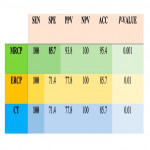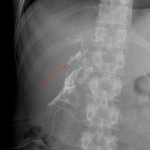The study included 44 patients with IBI after laparoscopic cholecystectomy, of whom 70.5% (n=31) were female and 29.5% (n=13) were male, aged 27 to 85 years, with a mean age of 62 years.
All patients in the study had at least one imaging study, of which 28 patients underwent the abdominal US, 27 patients had abdominal CT, 27 patients underwent ERCP, 32 patients had MRCP, and 16 patients had PTHC.
Of the 33 patients who underwent surgical classification of Strasberg et al in 28% (n=9) type A IBI were detected, type D were detected 15% (n=5), type E1 21% (n=7), E2 type 4 in 12% (n=4), type E3 was detected in 6% (n=2), E4 was surgically detected in 18% (n=6). In contrast, type B, C and E6 IBI were not surgically identified.
Of the 44 patients, MRCP with or without hepatic specific contrast was performed in 32 patients, 28 of whom were able to determine Strasberg's classification. Type E IBI were more frequently detected in the MRCP examination, of which E1 type injuries were present in 18% (n=5), E2 in 21% (n=6), E3 type in 14% (n=4), and E4 type in 25% (n=7). 18% (n=5) were diagnosed with type A injury and one patient was classified as a type D. For type E2 IBI see img 4.
Of the 44 patients, ERCP was performed in 27 patients, of whom 18 were verified by the Strasberg classification for IBI. Type A injury was in 22% (n=4), type D in 5% (n=1), type E1 in 33% (n=6), E2 in 28% (n=5), type E3 in 6% (n=1), E4 type also in 6% (n=1). For type A IBI see img 5.
Of the 44 patients, 27 underwent CT, of whom 16 patients were verified by the Strasberg classification for IBI. Type A damage was classified in 25% (n=4), type B damage in 6% (n=1), type E1 damage in 12% (n=2), E2 in 38% (n=6), type E3 damage in 13% (n=2), type E4 lesion in 6% (n=1).
Using Spearman's correlation, statistically significant, strong correlations between imaging methods and Strasberg classification were found for MRCP (rs = 0.835; p <0.001), ERCP (rs = 0.788; p = 0.001), and CT (rs = 0.887; p <0.001), between PTHC and Strasberg it was absent (p=0.028).
Assessing MRCP, ERCP, and CT on the same cohort, high SEN, SPE, and ACC were found for E type injuries, which shows strictures in the biliary tract – for MRCP 100%, 85.7%, 95.4% (p<0.001); for ERCP 100%, 71.4%, 85.7% (p=0.01); for CT 100%, 71.4%, 85.7% (p=0.01) respectively (tab.1).
High SEN, SPE, ACC were found for non-E type injuries, which characterises with leakage and ligations – for MRCP 85.7%, 100%, 95.4% (p<0.001), for ERCP 71.4%, 100%, 85.7% (p=0.01) (tab.2).










